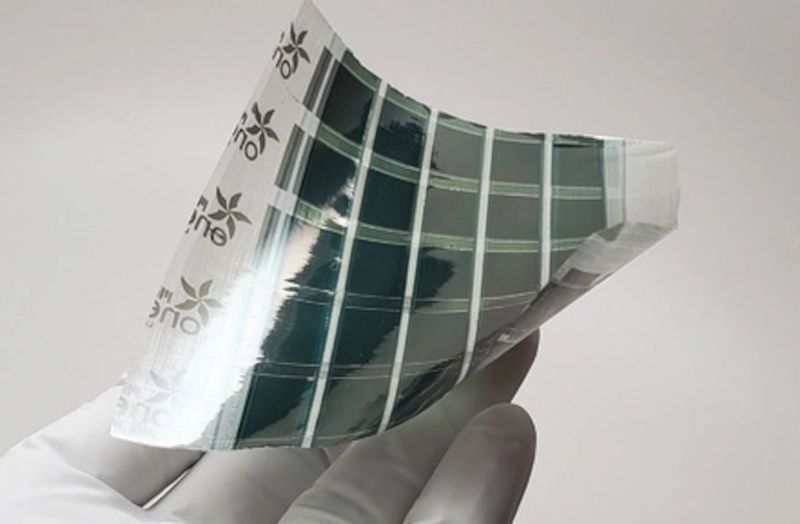MIT has been working on very thin solar cells made of a film just a few microns thick. The problem? The cells are so thin that they’re hard to work with. You could make a small solar cell on top of, say, a glass slide, but that’s not all that interesting since you can make perfectly good solar cells that are as fragile as glass using conventional techniques. But in a new paper, MIT researchers describe creating 50-micron-thin fabrics that can generate electricity from solar.
The process still involves using chemical vapor deposition to produce the solar cell on glass. However, the cells are removed from the glass, prepared with electrodes, and then transferred to a piece of fabric which acts as a new substrate.
The fabric used in the paper is a composite fabric known as Dyneema composite fabric. It uses ultra-high molecular weight polyethylene fibers and sheets of Mylar. This material has low weight but a very high strength. A UV cure adhesive bonds the fabric and solar cells.
Honestly, we doubt anyone will be making these in their garages anytime soon. But we would love to see what you could do with a roll of this fabric. Wearables, self-charging laptop bags, or solar-powered instruments in an airborne drone could all take advantage of the material’s flexibility and low weight.
















On boats, Bimini covers and spray dodgers are often make from Sunbrella fabric. The solar panels are often put elsewhere, or, if incorporated into a hard dodger or Bimini, then they can’t be easily folded away. This could allow the dodger and Bimini to do double duty.
The mechanical load was really benign, just rolling it up. Any significant stretching from say hailstones and it’s probably instantly kaput. Stretchable PV is a lot harder, you probably need to have lots of tiny but non stretchable patches connected by elastic electrodes.
Ha I was just about to say—wonder if it’s sturdy enough to be a sail? Highly doubt it, but fun idea
Right, or an electrically-heated hot-air balloon (just need to stay above the clouds, forever).
These modules may be lightweight and flexable, but they still have a long way to go efficiency-wise (is, in terms of Watts per square Meter) which for me and I suspect almost everyone is the most important metric.
To wit, according to the linked paper:
> The specific power of our integrated fabric-PV modules is 370 W kg−1, weighing 105 g m−2
Converting grams to kilos and multiplying these numbers, we get 370 * (105/1000) = ~38 W m-2.
Comparing to the “SunPower’s Maxeon Gen 5, 400 W Residential A-Series Panel” the paper mentions in the same paragraph, which yields 425W and measures 1.835m x 1016m resulting in 425 / (1.835 * 1016) = ~228 W m-2, we see the new cells generate almost 6 times less energy per area.
So, unless it improves very strongly in that aspect, I don’t see much future for it except in niche areas where little energy is needed *and* minimum weight is the most important factor.
But what’s the *weight* of your Maxeons? These sound like they should be much lighter. Skinning the top surface of airplane wings you may be able (with some onboard battery) to keep an ultralight aloft indefinitely. I like the solar tent idea, but a solar tarp to keep the batteries in my trailer maintained (while not exposing that very expensive single-crystal glass solar panel to the elements over the winter) sounds like a good idea.
Efficiency isn’t just about power generated per area in all the real world use cases though – if it is heavier, thicker, requires more supporting infrastructure than the efficiency of the system it is part of can be worse. For static installs weight won’t matter but that is not very true for most portable applications…
Also in this case if its flexible enough or can be made to deliberate origami into small spaces you can easily get far more solar power out for the volume required – so efficiency of your fold out solar backpack campers light for instance is actually going to be much better – 2 hours to charge vs 6 in the same volume and mass.
the roll to roll transfer process can scale this up to
mega output.
“dynema” is over the top,throw in some kevlar and
build bear proof solar tents
awsome
RV Awnings seems like a good application
Surprised no one has suggested solar sail on spacecraft.
I forget the physics: Does a solar sail need to reflect the photons, or is absorption enough?
I think absorption is fine, but you probably want something a whole lot lighter per square meter. Would probably be more optimal to have the sail reflect some light back to the hab module for power instead of rigging the whole thing up with photovoltaics, wiring, power management, w/e else
Reflection doubles your thrust for a solar sail, but if you can cope on half the thrust, or twice the area, and need electric power from photovoltaics then this could be worthwhile.
I can’t afford a dyneema backpacking tent now. No way will I be able to keep up with the power industry.
Tarp tent it is
Ben Krasnow will be making these in the near future i am sure
These are a lot like the roll-to-roll organic solar cells on polypropylene, only different substrate?
I’ve seen a few of these recently in the flesh, and they’re very cool, but put out very little power. (If that’s all you need, though, they’re amazing.)
https://hackaday.com/2022/11/22/a-hacker-walks-into-a-trade-show-electronica-2022/